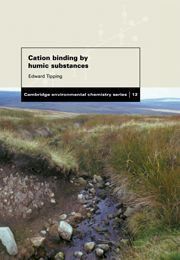Book contents
- Frontmatter
- Contents
- Preface
- 1 Introduction
- 2 Humic substances – a brief review
- 3 Environmental solution and surface chemistry
- 4 Proton dissociation from weak acids
- 5 Metal–ligand interactions
- 6 Methods for measuring cation binding by humic substances
- 7 Quantitative results with isolated humic substances
- 8 Cation binding sites in humic substances
- 9 Parameterised models of cation–humic interactions
- 10 Applications of comprehensive parameterised models
- 11 Predictive modelling
- 12 Cation–humic binding and other physico-chemical processes
- 13 Cation binding by humic substances in natural waters
- 14 Cation binding by humic substances in soils and sediments
- 15 Research needs
- References
- Index
6 - Methods for measuring cation binding by humic substances
Published online by Cambridge University Press: 18 August 2009
- Frontmatter
- Contents
- Preface
- 1 Introduction
- 2 Humic substances – a brief review
- 3 Environmental solution and surface chemistry
- 4 Proton dissociation from weak acids
- 5 Metal–ligand interactions
- 6 Methods for measuring cation binding by humic substances
- 7 Quantitative results with isolated humic substances
- 8 Cation binding sites in humic substances
- 9 Parameterised models of cation–humic interactions
- 10 Applications of comprehensive parameterised models
- 11 Predictive modelling
- 12 Cation–humic binding and other physico-chemical processes
- 13 Cation binding by humic substances in natural waters
- 14 Cation binding by humic substances in soils and sediments
- 15 Research needs
- References
- Index
Summary
Here a review is presented of methods for the quantification of cation binding, mainly at equilibrium. The principle of each method is explained, and its range of application and drawbacks indicated. The focus is on measurement with isolated humic samples, although some of the methods can be applied to field samples. Techniques for the determination of speciation in natural environmental samples – which will invariably involve humic matter – are reviewed in books edited by Tessier & Turner (1995) and Ure & Davidson (1995).
The humic sample
Ideally, the sample of humic matter to be investigated should be unaltered from its state in the natural environment, except that it should be freed of other chemical components. However, currently available isolation procedures are such that the introduction of artefacts cannot be ruled out (Section 2.2). Samples low in ash should be used, because residual mineral matter (oxides and aluminosilicates) may interact with both protons and metal cations and thereby distort the results.
For acid–base titrations, the humic sample will ideally initially be free of inorganic cations (except for H+) and anions, a state that can be achieved by passage of the material through a column of hydrogen-saturated cation exchanger, or by exhaustive dialysis. Alternatively, base cations and strong acid anions associated with the sample can be determined analytically, and taken into account when analysing the titration data (Section 6.2.2). However, this is satisfactory only if the base cations are weakly binding, which in practice means Na+ and K+.
- Type
- Chapter
- Information
- Cation Binding by Humic Substances , pp. 103 - 127Publisher: Cambridge University PressPrint publication year: 2002



